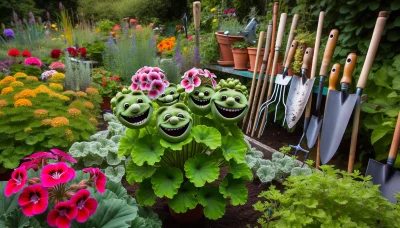Meadow sage Quiz
Test Your Knowledge
Question of
Introduction to Meadow Sage
Meadow sage, also known as Salvia nemorosa, is a perennial plant that has gained popularity among gardeners for its vibrant flowers and resilience. This plant is cherished for its ability to attract pollinators such as bees and butterflies, making it an excellent choice for eco-friendly gardens. Meadow sage blooms in various shades of purple, blue, pink, and white, adding a splash of color to garden landscapes from late spring to early fall. Its drought tolerance and low maintenance requirements make it a favorite among both novice and experienced gardeners. Furthermore, meadow sage's aromatic foliage is highly valued for its ability to deter deer and rabbits, providing a natural way to protect garden plants.
Types of Meadow Sage
- Caradonna - Known for its striking purple spikes and dark stems.
- May Night - Features deep indigo flowers and robust growth.
- East Friesland - Boasts vibrant purple blooms and a compact form.
- Snow Hill - Offers a contrast with its pure white flowers.
- Blue Hill - Celebrated for its sky-blue flowers and hardy nature.
- Rose Marvel - Distinguished by its large pink flowers and long blooming period.
- Amethyst - Named for its amethyst-colored flowers and attractive foliage.
- Bumbleblue - Perfect for attracting pollinators with its bright blue flowers.
- Midnight Model - Features deep blue blooms on a tall, elegant stem.
- Pink Profusion - Known for its profuse pink flowers and vigorous growth.
Planting Meadow Sage
Meadow sage, known for its vibrant flowers and resilience, thrives under specific conditions. Ideal soil for meadow sage is well-draining with a neutral to slightly acidic pH. This plant prefers full sun exposure, requiring at least 6 to 8 hours of direct sunlight daily to flourish and produce abundant blooms. When it comes to planting zones, meadow sage performs best in USDA zones 4 through 8. Ensuring these conditions will help your meadow sage grow healthily, contributing to a lush and vibrant garden.
Caring for Your Meadow Sage
- Watering: Water meadow sage deeply once a week, allowing the soil to dry out between waterings. During hot, dry periods, increase watering frequency to twice a week.
- Fertilizing: Apply a balanced, slow-release fertilizer in early spring as new growth appears. Avoid over-fertilizing, which can lead to weak growth and fewer blooms.
- Pruning: After the first flush of blooms fades, cut the plant back by one-third to encourage a second bloom period. In early spring, prune any dead or damaged stems to maintain plant health and shape.
Common Pests and Diseases
Meadow sage, a popular perennial known for its vibrant flowers and resilience, can still fall prey to certain pests and diseases. Among the most common pests are aphids and spider mites, which tend to attack the plant, sucking sap and causing the leaves to yellow and drop. Regular inspection and the application of insecticidal soap or neem oil can effectively manage these pests. Diseases such as powdery mildew and rust also pose a threat, particularly in humid conditions. Powdery mildew coats the leaves with a white, powdery substance, while rust appears as orange or brownish spots. Ensuring good air circulation, avoiding overhead watering, and removing affected foliage can help prevent and control these diseases. In severe cases, the use of fungicides may be necessary. By taking these steps, gardeners can help ensure their meadow sage plants remain healthy and vibrant.
Meadow Sage Companion Plants
| Companion Plant | Benefits |
|---|---|
| Lavender | Enhances fragrance and supports pollinators |
| Rosemary | Repels pests and attracts beneficial insects |
| Echinacea (Coneflower) | Attracts butterflies and supports biodiversity |
| Yarrow | Improves soil health and attracts pollinators |
| Black-eyed Susan | Creates a visually appealing contrast and supports wildlife |
FAQs on Growing Meadow Sage
-
What is the best time to plant meadow sage?
The best time to plant meadow sage is in the spring after the last frost, as this gives the plant a full growing season to establish itself.
-
How much sunlight does meadow sage need?
Meadow sage thrives in full sun, requiring at least 6 to 8 hours of direct sunlight each day.
-
What type of soil is suitable for meadow sage?
This plant prefers well-drained soil with a neutral to slightly alkaline pH. It is tolerant of poor soils but will perform best in richer soils.
-
How often should I water meadow sage?
Water meadow sage deeply once a week, allowing the soil to dry out between watering. This plant is drought-tolerant once established.
-
Is meadow sage resistant to pests and diseases?
Yes, meadow sage is generally resistant to pests and diseases, though it can occasionally be affected by powdery mildew in very humid conditions.
-
How do I propagate meadow sage?
Meadow sage can be propagated by seed, division, or cuttings. For best results, divide or take cuttings in the early spring.
-
Should I deadhead meadow sage?
Yes, deadheading spent blooms can encourage a second flowering in the late summer or early fall.
-
How do I prepare meadow sage for winter?
In colder climates, mulch around the base of the plant to protect the roots. In milder climates, meadow sage may remain evergreen throughout the winter.
-
Can meadow sage be grown in containers?
Yes, meadow sage can be successfully grown in containers. Ensure the container is large enough and has good drainage.
-
How tall does meadow sage grow?
Meadow sage typically grows between 18 to 24 inches tall, but some varieties can reach up to 3 feet.












